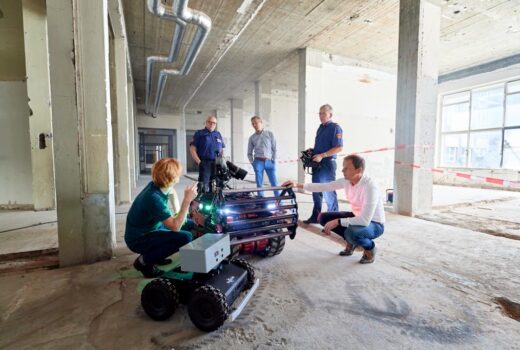Rolmodel voorzitter Europese Onderzoeksraad

De ERC meldt over de unanieme verkiezing van de Oostenrijksegeleerde: ‘She will take office on March 1st, 2010. The electionfollowed the resignation of the first ERC President, Prof. FotisC.Kafatos, announced in January, after three years of intensive andhighly respected leadership. Prof. Helga
Belangrijke rol
In een essay en groot interview heeft Pieter Leroy inhet Tijdschrift voor Sociologie in 2009, onder de titel’Controverses, kennissociologie en wetenschapsproductie: zoekennaar legitimiteit’ uitvoerig geschreven over het werk van Nowotnyen het belang daarvan:
“Het kernenergiedebat van de jaren ’70, markeert, zo blijktachteraf, de start van een nieuwe verhouding tussen kennis,samenleving en beleid. Mede door toedoen van de antinucleairebeweging werd de bevoorrechte en behoorlijk besloten relatie tussenoverheid, bedrijfsleven en kennisinstituten geleidelijk engedeeltelijk doorbroken.
Politiek gesproken leidde dat tot verlies aan legitimiteit en, tercorrectie daarvan, tot het experimenteren met nieuwe vormen vanbesluitvorming over hoogtechnologische opties en investeringen.Binnen en rondom de wetenschap leidden de controverses rondomkernenergie en andere technologie tot de erkenning vanwetenschappelijke onzekerheid en, ook daar, tot een zoektocht naarhet herstel van aangetaste legitimiteit. het een en het anderzorgde voor grondige discussies en vernieuwing in dekennissociologie.
Naast vele anderen heeft Helga Nowotny een belangrijke rol gespeeldin die discussies en vernieuwing. naast epistemologische en andere,op het eerste gezicht intern-wetenschappelijke kwesties, warenvooral veranderingen in de organisatie van de wetenschappelijkekennisproductie, in de maatschappelijke rol van wetenschap enkennis, en in de zoektocht naar meer legitieme (wetenschappelijke)kennis haar centrale thema’s.”
De glazen genen
Haar laatste boek verscheen bij Suhrkamp in deprestigieuze Edition Unseld reeks en heet ‘Die gläsernen Gene. DieErfindung des Individuums im molekularen Zeitalter.’ U leest deEngelstalige synopsis daarvan hier:
‘This book emerged from the close collaboration between ascience researcher and a molecular biologist. The authors analyzehow the life sciences have affected and can be expected to affectsociety. Their “co-production” has the effect that, at the sametime as the gene is scientifically redefined, so too the individualand her multi-faceted membership in social and genetic communitiesis defined anew. The book thoroughly explores the resultingtensions.
While new scientific and biotechnological breakthroughs pose achallenge to the existing social order, human technologiescontribute to the stabilization of the newly arising configurationsof natural and social order. In pluralistic societies, the newforms of life combine with new forms of living together in society.The resulting arrangements between biotechnological and socialinnovations point in the direction that both science and theaccompanying democratic experiments will go.
Theme 1: Today there are unprecedentedpossibilities to give visibility to things and processes in theinterior of the body. The molecular gaze penetrates the genes,instead of the organs. But that doesn’t make things and theircontexts simpler. On the contrary! Under the dominance of themolecular gaze, knowledge has become action. Today, knowing aboutlife means changing life.
Despite the widespread feeling of standing on the threshold of anew age, what is new enters into as-yet untested configurationswith the old in everyday life. What stands in the focus of publiccontroversies today was long since thought about, dreamed in myths,or prefigured in the long, common history of the domestication ofplants and animals. This is true in particular about two areas inwhich a large role is played by both the newly achieved visibilityof the gene and the continuum in the apparent discontinuity createdby the new: the assisted reproduction technologies (ART) and thestriving to enhance achievement levels, with its controversial butpioneering potential.
Our thesis is that the more we know about our own biology, theless we are able to fit this knowledge into a coherent whole. Inthe process of the molecular reduction of functioning as a person,the knowledge thereby gained takes on an essentialist shape. Whenthe “epistemic things” are separated from their context, we losethe societal contexts in which both reproduction and the strivingfor human enhancement are embedded. The new visibility of the genestempts us to attribute an essentialist status of their own to thenewly created forms of life. They are – falsely – regarded asagents that can act of their own accord.
Theme 2: The ancient striving forhappiness and for the improvement of human capacity will soon beachieved through genetics, as well. This will result in newdiscontinuities that attain great explosive power, especially inathletics. Paradigmatically for the striving to enhance achievementthat characterizes our life today, here what is natural, what comesfrom inside, is mixing with what is artificial and comes from theoutside – and it is difficult to distinguish the two.
We use the example of doping in sports to show how, in the nameof a fictional naturalness and a fictional equality, an ultimatelyillusionary cleansing of (natural) life is striven for. Decisivefor this are not least the achievements of molecular genetics inthe last two decades, which have led to a critical reexaminationand revision of the concept and function of genes.
These are increasingly understood as epigenes, i.e., asmechanisms of inheritance that do not depend on DNA sequences. Thereason developments in sports are so interesting is that theyparadigmatically reveal that a rigid boundary cannot be maintainedbetween artificial/technological and natural.
Theme 3: Who and what belong to whomare questions about identity, ownership, and belonging that runthrough all encounters with biotechnology. They make clear thefault lines along which diverse and controversial designs for thefuture are imagined, articulated, and decided in public debate. Theprocesses on the molecular level lead on the societal level toaffiliations that are equally controversial and in need ofclarification.
Interdependencies on the molecular level find correspondence ininterdependencies between individuals and community. We investigatetwo aspects of controversial membership. The first is controversiallines of descent, which make visible an unsuspected tension betweenthe person and the community. The second aspect is the question ofrights of ownership over genes and other entities. Whatbelongs to whom also decides who belongs to whom.
Theme 4: For society, the questionarises of how the molecularly created forms of life can beintegrated in the existing social order. Of the fullness ofscientific-technological potential, what should and what can berealized? Three discourses provide partial and contradictoryanswers: the discourse of innovation, that of risk, and that ofvalues. The last, in particular, is characterized by a veritableflood of images and associations that – not controllable by anyone- enter into unforeseeable connections with the new forms of lifeand shape people’s imagination and everyday experience. Many ofthese images change our perception of nature as the unchangingmoral authority that it was for centuries. Nature is reduced tomatter that can be manipulated and patented.
But precisely this way of looking at things arouses oppositeforces that want to hold fast to an image of unchanging nature. Inthis fissured moral landscape, the genetic visibility of lifeencounters the visibility of (reinvigorated) values. But in apluralistic society, values are and remain heterogeneous. Theychange and they contradict each other. The struggle to shape thefuture has begun, but however open and uncertain the future is, itmust make it possible to live together in a pluralisticsociety.
Theme 5: The social order is comingapart at the seams because of the offerings of the life sciences.The task of stabilizing it is being taken up by human technologiesthat supplement and support each other. The newly created forms oflife and other biological entities must be integrated in thesociety in such a way that human beings and the artifacts they havecreated can coexist in an acceptable way.
Human technologies have suitable mechanisms and procedures for thistask; of course, they must be adjusted to the respective context.In living together in society, human technologies functionsimilarly to material technologies: once they are established, theyreplace the necessity to create consensus again and again anew.They create standards that serve as a reference point and benchmarkfor otherwise incomparable situations, for the use of variousmeans, and for suitable behavior.
The oldest and most proven human technology is law, whichconstantly confronts great challenges as new technologies areintroduced. Since industrialization, the aim has been to adjusttechnology to the needs of people, rather than vice versa; the aimis technology’s humanization. The relatively new instrument ofgovernance is another human technology that serves to translate thewidest variety of often incommensurable interests of a growingnumber of actors into political options and to manage the resultinginterdependencies.
Bio-ethics is a third human technology that has becomeindispensable for the life sciences. It is meanwhile highlyprofessionalized and has established itself as the generally validcurrency of a global moral economy. Liberal democratic societiesapply these human technologies with varying success in the attemptto shape their controversial future pluralistically.
Theme 6: The efficient arrangement ofstandards based on the measurement and unification of molecularlife finds its correlate in standards for the right socially,politically, and ethically responsible behavior. This convergenceopens the view onto a future in which the standardization of lifeis explicitly pursued in this double sense. One of the most timelyareas of research, synthetic biology, has set itself the goal ofreordering life by designing its components. To this end, however,these must first be made standardizable. Synthetic biology developsbeyond the ad hoc use of technical procedures to a systematicallyoperated enterprise.
An example of this is the complete sequencing of the ocean’smicrobial diversity. Starting from the parts gained in this way,artificial modules will be produced to be assembled anew forspecific functions. Standards and an accessible register ofstandards play a decisive role in this process. We will use anastonishing example to elucidate one of the characteristics ofsynthetic biology: the coupling of biological with socialstandards, in this concrete case with moral values.
Design will become the guiding principle for synthesizing thefuture. On the one hand, this is a consistent further developmentof engineering sciences and their ideal of designing. On the otherhand, it makes it clear that designing standards is far more than aquestion of technology.
Theme 7: The conviction that onestands before an epochal breakthrough with “revolutionary”possibilities is not new; it accompanies every technologicalvision. In the face of the fascination that the new inherently hasand of its supposed discontinuity, however, we must not lose sightof the persistence and the “shock of the old”. The continuity ofsocietal developments should not be underestimated. In the lastchapter, we attempt a synthesis consisting in measuring therelationship between three reference points, a kind oftriangulation. This aims to open up the view to a possible shapingof the future.
The first reference point is an increasingly globally operatingscience whose form of organization is rapidly changing. Ascientific super-organism is emerging whose decentralized parts areall networked together. The second observation has to do with theexperiences of individuals and the question of what it means forthem to find themselves in voluntary and involuntary amalgamationson the molecular level. Their identity and (multiple) affiliationwill be genetically and socially redefined. The third referencepoint is the institutions. Their task is to stabilize socialpractices whose official status is still controversial or not yetdetermined, so that people can live together pluralistically.
Experimentation with new forms of life and living togetherrequires legitimated “playgrounds”. The interplay of these threereference points reveals the primacy of politics, which redefinesthe options of society and its individuals, “beyond the arbitrarypolytheism of social values and individual opinions and”references” (Thévenot).
Meest Gelezen
Vrouwen houden universiteit draaiende, maar krijgen daarvoor geen waardering
Wederom intimidatie van journalisten door universiteit, nu in Delft
‘Burgerschapsonderwijs moet ook verplicht worden in hbo en wo’
Raad van State: laat taaltoets nog niet gelden voor hbo-opleidingen
Hbo-docent wil wel rolmodel zijn, maar niet eigen moreel kompas opdringen



